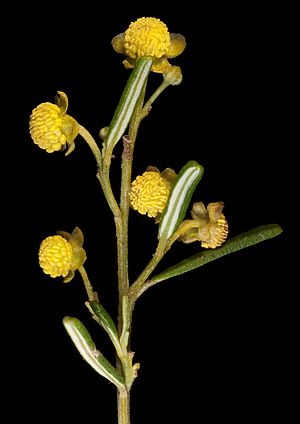Beyeria lechenaultii facts for kids
Quick facts for kids Beyeria lechenaultii |
|
|---|---|
 |
|
| Male flowers | |
 |
|
| Female flowers | |
| Scientific classification | |
| Genus: |
Beyeria
|
| Species: |
lechenaultii
|
| Synonyms | |
|
Hemistemma lechenaultii DC. |
|
Beyeria lechenaultii is a type of flowering plant often called the pale turpentine bush. It belongs to the spurge family, called Euphorbiaceae. This plant is endemic to Australia, which means it naturally grows only there.
The plant was first described in 1817 by a scientist named Augustin Pyramus de Candolle. He gave it the name Hemistemma lechenaultii. Later, in 1866, another scientist, Henri Ernest Baillon, moved it to the Beyeria group of plants. The name lechenaultii honors a French botanist, Jean-Baptiste Leschenault de La Tour.
About the Pale Turpentine Bush
The pale turpentine bush is a shrub that can grow up to 1.5 meters (about 5 feet) tall. It feels a bit sticky to the touch.
Its leaves are usually long and narrow, or shaped like an oval. Sometimes, the edges of the leaves curl backwards. The underside of the leaves feels soft and fuzzy, except for the main vein.
Flowers and Seeds
This plant has separate male and female flowers.
- The male flowers grow in small groups of one to three. They are found on sticky stalks.
- The female flowers grow alone. Their stalks are whitish and get longer when the plant starts to form fruit.
Both male and female flowers have small, leaf-like parts called sepals. The female flowers have sepals that are about 2 mm long and whitish.
After flowering, the female flowers develop into a fruit called a capsule. This capsule is shaped like an egg or a ball. It usually contains three reddish-brown seeds, each about 5 mm long. The plant typically flowers in the spring.
Where it Grows
In New South Wales, the pale turpentine bush often grows as a smaller plant under taller trees. It is found in areas known as mallee communities.
Traditional Uses
The Noongar people, who are Indigenous Australians from southwest Western Australia, used this plant. They would make a special drink from the leaves. This drink was used to help treat illnesses like tuberculosis and fevers.

